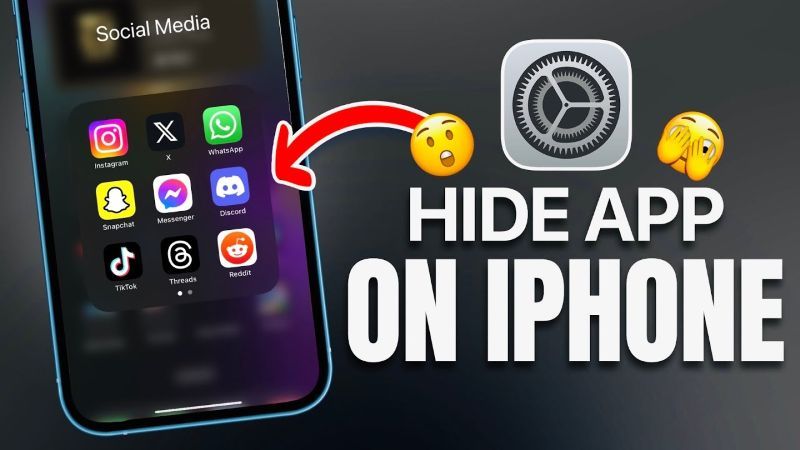

As iPhone users, we often find ourselves seeking innovative ways to enhance our device's functionality and protect our privacy. Let's explore this topic in more detail with Tiny Fishing below, as we delve into the world of hidden features and clever tricks that can transform your iPhone experience. From concealing sensitive photos to discreetly tucking away apps, we'll uncover the secrets to maintaining your privacy while maximizing your iPhone's potential. Whether you're a tech enthusiast, a busy professional, or simply someone looking to get more out of their device, these tips will help you navigate the ever-evolving landscape of iOS and discover features that Apple doesn't always advertise. So, let's embark on this journey to unlock the full power of your iPhone and learn how to keep your personal information secure in style.
In today's digital age, privacy has become a paramount concern for smartphone users, especially those who rely heavily on their iPhones for both personal and professional matters. As we store an increasing amount of sensitive information on our devices, from personal photos to confidential work documents, the need to protect this data has never been more critical. Apple has long been at the forefront of mobile security, but many users are unaware of the full extent of privacy features available on their iPhones.
The ability to hide photos and apps on your iPhone is not just about keeping secrets; it's about maintaining control over your digital footprint and ensuring that your personal information remains private, even when your device is in the hands of others. Whether you're lending your phone to a friend, sharing your screen during a presentation, or simply want to declutter your home screen, knowing how to conceal certain elements of your iPhone can provide peace of mind and enhance your overall user experience.
Moreover, as we become more reliant on our smartphones for various aspects of our lives, the line between personal and professional use often blurs. This makes it even more crucial to have the ability to compartmentalize different areas of our digital lives. By mastering the art of hiding photos and apps, you can create a more organized and secure environment on your iPhone, tailored to your specific needs and preferences.
Read more: Editing Photos on iPhone Like a Pro: Step-by-Step Guide
One of the most sought-after privacy features on the iPhone is the ability to hide photos. Whether you have sensitive personal images or simply want to keep certain memories private, iOS offers several methods to conceal your pictures from prying eyes. The most basic approach is to use the built-in "Hide" feature in the Photos app. To do this, select the photos you want to hide, tap the share button, and choose "Hide" from the options. These photos will then be moved to a special "Hidden" album, which is tucked away in the Albums tab.
However, for those seeking an extra layer of security, it's worth noting that the Hidden album itself can be hidden from view. With iOS 14 and later, you can go to Settings > Photos and toggle off the "Hidden Album" option. This removes the Hidden album from the Albums tab entirely, making it much more difficult for anyone browsing your photos to stumble upon your private images.
For even more robust protection, consider using third-party apps that offer password or biometric protection for your photos. These apps often provide features like decoy passwords, encrypted storage, and even the ability to disguise themselves as innocuous applications like calculators. While these options require additional setup, they can offer peace of mind for those who prioritize privacy above all else.
Beyond the basic hiding features, there are more advanced techniques that savvy iPhone users can employ to keep their photos private. One such method is to create a secure note in the Notes app and add photos to it. By locking the note with a password or Face ID, you can create a protected space for your most sensitive images that's separate from your main photo library.
Another clever trick is to use the Files app to your advantage. By moving photos to a folder within the Files app and then deleting them from your Photos app, you can keep images accessible yet hidden from casual browsing. This method requires a bit more manual management but can be an effective way to organize and protect specific sets of photos.
For those who frequently share their iPhone screen or hand their device to others, consider creating a separate photo album with a curated selection of images. This "safe" album can be quickly accessed when needed, allowing you to share photos without worrying about accidentally revealing private content.
While hiding photos is a common privacy concern, many iPhone users also seek ways to conceal certain apps from view. Whether it's to maintain a clutter-free home screen or to keep sensitive applications away from prying eyes, there are several methods to hide apps on your iPhone. The simplest approach is to create a folder and move the app you want to hide to a secondary or tertiary page within that folder. This doesn't completely conceal the app but makes it less immediately visible.
For a more thorough hiding method, you can take advantage of the App Library feature introduced in iOS 14. By removing an app from your home screen, it remains accessible through the App Library but doesn't appear in your regular app layout. To do this, long-press on the app icon, select "Remove App," and then choose "Remove from Home Screen" instead of "Delete App."
Another clever trick is to use the Screen Time feature to restrict access to certain apps. By setting up Content & Privacy Restrictions in Screen Time settings, you can essentially hide apps by making them inaccessible without a passcode. This method is particularly useful for parents who want to control their children's access to specific applications.
For those who want to take app concealment to the next level, consider creating a "stealth mode" for your iPhone. This involves setting up a Focus mode (formerly known as Do Not Disturb) that not only silences notifications but also customizes which apps and widgets appear on your home screen. By carefully curating this Focus mode, you can instantly switch to a clean, professional-looking home screen that reveals only the apps you want others to see.
Additionally, you can use the Shortcuts app to create custom icons for your apps. By doing this, you can disguise apps with innocuous icons or even hide them in plain sight by making them look like system settings or utilities. While this method requires some initial setup, it can be an effective way to maintain privacy while still keeping your apps easily accessible to you.
Read more: iPhone Privacy Settings You Should Change Right Now
As we explore these various methods for hiding photos and apps on your iPhone, it's important to strike a balance between privacy and convenience. While it may be tempting to hide everything behind layers of security, this can often lead to a frustrating user experience. The key is to identify which elements of your iPhone truly need protection and focus your efforts on those areas.
Consider creating a tiered system of privacy on your device. For instance, you might keep everyday photos and apps easily accessible, use basic hiding features for personal but non-sensitive content, and reserve the most robust security measures for truly confidential information. This approach allows you to maintain a streamlined, efficient iPhone experience while still ensuring that your private data remains protected.
It's also worth noting that as iOS continues to evolve, new features and options for privacy and customization are regularly introduced. Staying informed about these updates can help you fine-tune your privacy strategy and take advantage of the latest tools Apple provides. Regularly reviewing your privacy settings and adjusting them as needed is a good habit to develop, ensuring that your iPhone remains a secure and personalized device that truly works for you.
As we look to the future, it's clear that privacy will continue to be a major focus for Apple and iOS development. With each new iteration of the operating system, we can expect to see more sophisticated tools for managing our digital privacy. From advanced AI-driven photo organization that can automatically identify and protect sensitive images, to more granular controls over app permissions and data access, the landscape of iPhone privacy is constantly evolving.
One emerging trend to watch is the integration of privacy features with cloud services. As more of our data moves to the cloud, the ability to seamlessly manage privacy across devices and platforms will become increasingly important. We may see innovations in how hidden photos and apps are synced and protected across multiple Apple devices, ensuring that your privacy settings follow you no matter which device you're using.
Another area of potential development is in the realm of contextual privacy. Future iOS versions might offer more intelligent, situation-aware privacy settings that automatically adjust based on your location, time of day, or even the people around you. This could mean that your iPhone automatically enters a more private mode when you're in certain locations or switches